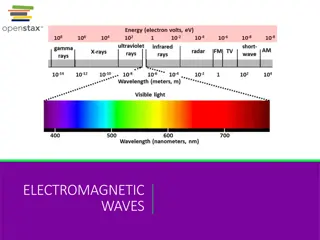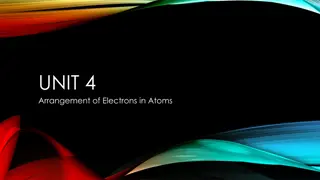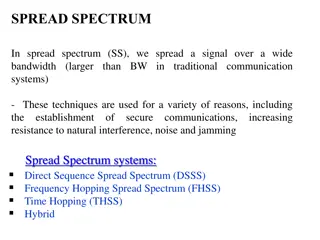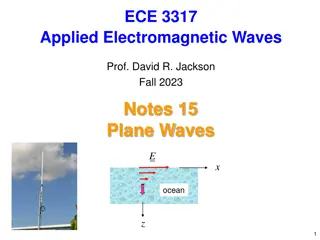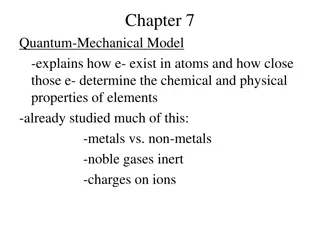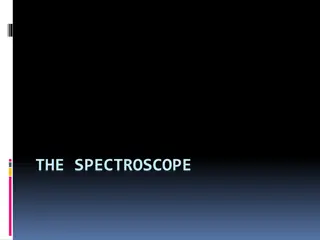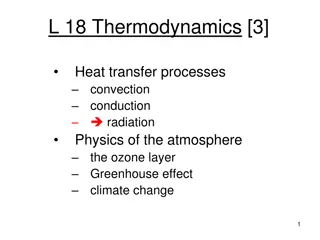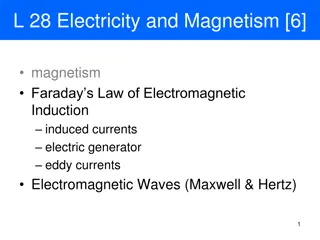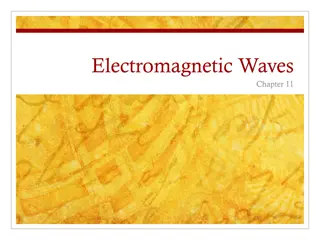Understanding the Electromagnetic Spectrum: A Comprehensive Overview
The electromagnetic spectrum encompasses a vast range of frequencies and wavelengths of electromagnetic radiation. This seminar presentation delves into the definition, uses, significance, and formulas associated with the electromagnetic spectrum. Covering topics from radio waves to cosmic rays, it explores the various types of electromagnetic radiation and their applications in different fields.
Download Presentation

Please find below an Image/Link to download the presentation.
The content on the website is provided AS IS for your information and personal use only. It may not be sold, licensed, or shared on other websites without obtaining consent from the author. Download presentation by click this link. If you encounter any issues during the download, it is possible that the publisher has removed the file from their server.
E N D
Presentation Transcript
SeminarPpt.com Seminar on Electromagnetic Spectrum Submitted to: Seminarppt.com Submitted By Seminarppt.com
Table Contents Definition Introduction Electromagnetic Waves Uses of Electromagnetic Spectrum Significance of Electromagnetic Spectrum Formulas for Electromagnetic Radiation Conclusion 2
Definition Electromagnetic spectrum in simple terms is defined as the range of all types of electromagnetic radiation. 3
Introduction The electromagnetic spectrum is a range of frequencies, wavelengths and photon energies covering frequencies from below 1 hertz to above 1025 Hz corresponding to wavelengths which are a few kilometres to a fraction of the size of an atomic nucleus in the spectrum of electromagnetic waves. Generally, in a vacuum electromagnetic waves tend to travel at speeds which is similar to that of light. 4
Electromagnetic Waves The entire range (electromagnetic spectrum) is given by radio waves, microwaves, infrared radiation, visible light, ultra-violet radiation, X-rays, gamma rays and cosmic rays in the increasing order of frequency and decreasing order of wavelength. The type of radiation and their frequency and wavelength ranges are different. 6
Uses of Electromagnetic Spectrum Radio: A radio basically captures radio waves that are transmitted by radio stations. Radio waves can also be emitted by gases and stars in space. Radio waves are mainly used for TV/mobile communication. 9
Uses of Electromagnetic Spectrum Microwave: This type of radiation is found in microwaves and helps in cooking at home/office. It is also used by astronomers to determine and understand the structure of nearby galaxies and stars. 10
Uses of Electromagnetic Spectrum Infrared: It is used widely in night vision goggles. These devices can read and capture the infrared light emitted by our skin and objects with heat. In space, infrared light helps to map the interstellar dust. 11
Uses of Electromagnetic Spectrum X-ray: X-rays can be used in many instances. For example, a doctor can use an x-ray machine to take an image of our bone or teeth. Airport security personnel use it to see through and check bags. X-rays are also given out by hot gases in the universe 12
Uses of Electromagnetic Spectrum Gamma-ray: It has a wide application in the medical field. Gamma-ray imaging is used to see inside our bodies. Interestingly, the universe is the biggest gamma-ray generator of all. Ultraviolet: Sun is the main source of ultraviolet radiation. It causes skin tanning and burns. Hot materials that are in space also emit UV radiations. 13
Significance of Electromagnetic Spectrum The electromagnetic waves in these different bands have different characteristics depending upon how they are produced, how they interact with matter and their practical applications. Maxwell s equations predicted the existence of an infinite number of frequencies of electromagnetic waves, all travelling with the speed of light. 14
Significance of Electromagnetic Spectrum This is the first indication of the existence of the entire electromagnetic spectrum. Nonetheless, the main significance of the electromagnetic spectrum is that it can be used to classify electromagnetic waves and arrange them according to their different frequencies or wavelengths. 15
Formulas for Electromagnetic Radiation The frequency(f), speed(c), energy(E), wavelength( ) of electromagnetic waves are related as: where: c = 299792458 m/s is the speed of light in a vacuum h = 6.62607015 10 34 J s = 4.13566733(10) 10 15 eV s is Planck s constant. 16
Conclusion The electromagnetic spectrum is a range of wavelengths of electromagnetic radiation. From long to short wavelength, the EM spectrum includes radio waves, microwaves, infrared, visible light, ultraviolet, x-rays and gamma rays 18
References Wikipedia.org Google.com Seminarppt.com Studymafia.org


